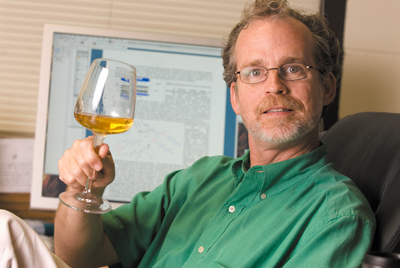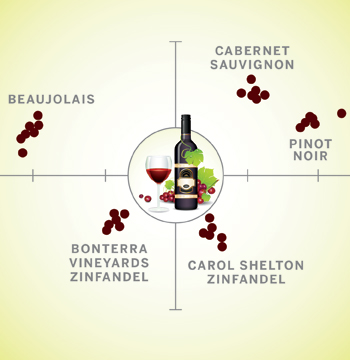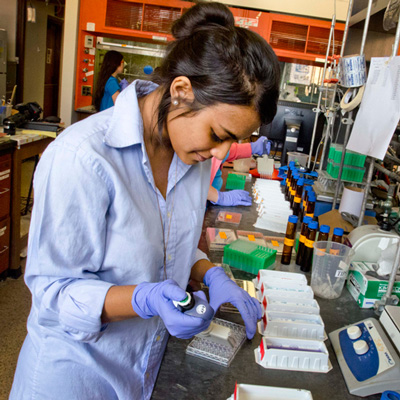 Professor Eric Anslyn received money from a class action suit to support research on the chemistry of wine, which is a project being worked on by undergrads in the Freshman Research Initiative.
Professor Eric Anslyn received money from a class action suit to support research on the chemistry of wine, which is a project being worked on by undergrads in the Freshman Research Initiative.A chemistry professor and his team of undergraduate student researchers are benefiting from $165,000 in funding from an unusual source: a class action lawsuit over fraudulently labeled wine.
Eric Anslyn, the Norman Hackerman Chair of Chemistry in the College of Natural Sciences, has been using wine as the primary test substance for the development of a device that mimics the human senses of taste and smell.“Wine is pretty complicated stuff, and contains many chemical compounds—such as tannins—whose structures and levels are unique to each varietal. These chemicals are difficult to distinguish, yet humans can do it through taste and smell,” says Anslyn.
Undergraduates in Anslyn’s Freshman Research Initiative stream, “Supramolecular Sensors,” and the students' former and current research educators Alona Umali and Eman Ghanem, have been working on the wine research for more than four years. The research has already born fruit.
Anslyn and his students published a 2010 paper in Chemical Science on how the device had become sophisticated enough to discriminate between different wine varietals.
Little did Anslyn know this very research would be a key factor in a trans-Atlantic fraud case.
The Crime
In 2010, several French grape growers and wine producers were found guilty in France for defrauding two American wine companies from Northern California, Gallo and Constellation. The French group was accused of purposely selling the companies wine of the wrong grape varietal—they said the grapes were pinot noir, but they were actually gamay. This is a serious crime in France, and several people were thrown in jail or fined.
On this side of the Atlantic, Gallo and Constellation learned they had been defrauded but decided not to pull their mislabeled products from the shelves. Wine consumers who thought they were getting a nice bottle of pinot noir had been duped.

When this came to light, a class action suit for nearly $2 million was filed against the two American wine companies.
One day, Anslyn received a surprise phone call from an attorney for Gallo and Constellation, telling him about a settlement agreement for the lawsuit.
“It’s quite intriguing to me because all of this was going on behind the scenes as we were working on the science,” says Anslyn, a University Distinguished Teaching Professor. “The day the attorney called me, he guided me to a website, and there I was mentioned in a court settlement.”
The lead plaintiff learned about Anslyn’s research through stories about the work in two popular wine magazines, Wine Spectator and Wines and Vines.
As part of class action suits, any money not claimed by the public must be directed to efforts to prevent the kind of wrongdoing brought about in the lawsuit. In this case, the idea was to fund research that could have prevented the two companies from being defrauded in the first place. Anslyn’s research, and that of his collaborator at University of California – Davis (Dr. Hildegard Heymann), was the perfect fit. They split the leftover money.
The Science
Anslyn’s device works a bit like a human tongue.
The human body uses receptors on the tongue and nasal cavity to bind numerous chemicals in food. Every food substance carries hundreds of chemicals; over a lifetime a person can encounter millions of different chemicals while eating.
The brain takes this array of signals and creates a pattern. Every food sends a different pattern of signals to the brain, which manifests in the difference in flavor between, for example, chicken and beef. Each time that food is consumed it sends that specific mix of signals to the brain and it is “tasted” uniquely. Anslyn has taken this premise and put it to work in his lab.

“We wanted to do this in a fashion analogous to natural taste receptors but use receptors that we construct in the lab that bind to various chemicals in wine,” he explains. “We have constructed plates with numerous receptors inside them, made out of peptides, metals and pH indicators. We put the plates in contact with the wine and because each receptor reacts in different ways with different wines, they interpret the wines’ properties.”
The Anslyn group engineered the receptors to interpret properties of wine by changing color, which is then read by a spectrometer. A computer program then constructs patterns from the color changes. Each wine varietal creates a different pattern, so it can be distinguished from another varietal.
“We could ultimately be able to test in advance not only the varietal but also what the human response would be to a certain wine,” Anslyn adds. “It could be something as subtle as aftertaste and astringency or even the overall quality of a varietal.”
Carrying on his research thanks to this strange series of events is exciting to Anslyn. A string of lawsuits that began across the Atlantic isn’t quite where labs predict their funding to come from, but it’s an interesting tale to tell, he said.
“This really shows the power of communicating research,” he said, “and what it can do for the students, because now they get to continue gaining experience in this research area.”
Anslyn says the FRI stream is now figuring out how to detect the types of grapes in wine blends, say a cabernet sauvignon-merlot.
“Although we ultimately want to use our device on solutions other than wine, such as urine, blood, and in industrial applications, I thought wine was of great interest as a test solution that we could also develop an undergraduate lab around,” Anslyn says.
The unexpected funding for wine analysis will also help them further develop basic principles for the device, he says, with the goal of using it on urine or blood to make complicated and sophisticated health diagnoses.

















Comments 2
In the photograph,Rabia working in the laboratory appears to be wearing the proper personal protection equipment except for safety glasses. Where are the safety glasses?
as a psychologist and wine collector, i have great interest in your work and hope that you continue your efforts. what is the best venue for me to keep track of what you are doing? you talk about being able to distinguish one grape variety from another. have you made any effort to make more specific distinctions, such as cabernet from california versus cabernet from france? how about elements of spectral images for wines rated 95 points or above? how about, man versus machine? say, a panel of masters of wine vs. your technology to re-create the paris tasting.